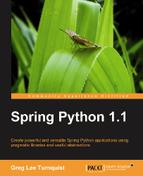There is a powerful debate in the technical community about whether or not IoC is of any value in dynamic languages such as Python, Ruby, and others. This section addresses several of the arguments, and shows how IoC definitely has value in any language. If you are already sold on the idea of IoC, you can skip this section and learn about more options to configure IoC definitions provided by Spring Python.
One argument is that IoC was invented as a paradigm to facilitate static languages, particularly Java. In the dynamic world, where passing around objects with handles is much more fluid, it is understandable that IoC may not solve as many problems as it does for static languages such as Java. While it is true that many Java developers that engaged in using IoC frameworks saw considerable leverage in productivity, it is also credible to not leave dynamic languages out of this.
The strongest principle that transcends the dynamic/static divide and is handled by IoC is DRY (Don't Repeat Yourself). By defining the creation of an object in one place, and being able to use that definition repeatedly is very useful, and makes it easy to adjust how the object is created.
One keen Ruby developer went through several phases of developing a Ruby IoC solution. The first round involved static configuration files very similar to the XML option. Later on, he realized that coding a Ruby DSL was simpler, easier to read, and more of the Ruby way. Finally, he realized that using Ruby directly in his code without the framework was actually easier and more salient. In finishing his blog article, he alludes to the fact that he uses DI every day. He just doesn't need a framework to do it.
In response, I am the first person to say that not every object created in a system needs to be served up by an IoC container; just the critical ones that would benefit from being swapped with test doubles, environmental changes, and wiring up different configurations for different customers. For example, coding small scripts and simple apps may actually not require any IoC at all. However, as our apps grow, the need to manage dependencies and object creation grows, and in those situations, Spring Python's IoC container can meet those needs. IoC also provides easy solutions for situations that need remoting, transactions, security, and other.
Opponents to dynamic IoC solutions have suggested that these solutions are simple port jobs and are really more for people not familiar with the dynamic language environment. In essence, people that like IoC when coding statically with C# or Java, want the same warm comforts in Python. While Spring Python has utilized some of the same class names as Spring Java, it is by no means a simple port job. Spring Python has ported many of the concepts but not the code. One of the best examples of this is Spring Python's security module. The architecture of Spring Security (originally known as Acegi Security) has become a de facto security standard in the Java industry. Their architectural concepts involve using a common set of interfaces to link into countless security systems such as database, X.509, LDAP, CAS, kerberos, OpenID, OpenSSO, and more, without having to get tied down to a specific API. Instead, the concepts of authentication and authorization have been abstracted to the right level, such that it is easy to add security after a system has been developed without major rework. The credit for this strongly resides in the power of IoC and its ability to wrap this critical service around already written business logic. It would be foolish to pass up this powerful security architecture on the basis of simple static versus. dynamic arguments.
Another argument tends to be based on Spring Java and its historical use of XML for configuration files. While XML is commonly used for many Java-based frameworks, the Python community tends to avoid XML unless customer requirements dictate otherwise. Some developers have criticized Spring Python for being an XML-based container. However, this book has already shown pure Python container definitions. Developers don't have to use XML at all to harness the power of Inversion of Control. By using Python directly for container definitions, the following powerful options are available:
- We can code a switchable context where the container reads the hostname and deduces whether it is running in development, test, or production environment
- We can code a clustered context where we vary object configurations based on which side of a cluster we are running
- We can write code that reads extra properties from an external source, like an Apache web server's
httpd.conffile, allowing us to stay nicely integrated - We can look up object properties in a database
Frankly, the options are limitless, given the power of Python and the added utilities Spring Python provides
